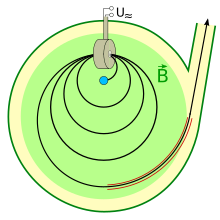87:
27:
98:
is a larger-scale microtron which uses two electromagnets instead of one. Both electromagnets supply a homogeneous magnetic field in a half-circle formed region, and the particles path between both magnets is thus straight. One advantage of this is that the accelerator cavity can be larger, enabling
77:
In a microtron, due to the electrons' increasing momentum, the particle paths are different for each pass. The time needed for that is proportional to the pass number. The slow electrons need one electric field oscillation, the faster electrons need an integer multiple of this oscillation.
106:
The linac is placed near the edge of the gap between the dee-shaped magnets. The remainder of the gap is used for focusing devices. The electron is readmitted to the linac after each revolution. This procedure can be repeated until the increasing
111:
of the particle's path makes further acceleration impossible. The particle beam is then deflected into an experiment area or a further accelerator stage. The world's largest racetrack-microtron is the
58:
around 1944. The kinetic energy of the particles is increased by a constant amount per field change (one half or a whole revolution). Microtrons are designed to operate at constant field
144:
Dehn, M.; Aulenbacher, K.; Heine, R.; Kreidel, H. -J.; Ludwig-Mertin, U.; Jankowiak, A. (2011). "The MAMI C accelerator".
237:
19:
This article is about a type of particle accelerator. For the character of that name in the
Micronauts toy line, see
242:
218:
67:
127:(no radiation equilibrium) and a high repetition rate (equal to the operation frequency of the linac).
153:
43:
169:
100:
51:
191:
50:
in which the accelerating field is not applied through large D-shaped electrodes, but through a
30:
Particles in a classic microtron get emitted from a source (blue), accelerated once per turn (
187:
161:
55:
31:
112:
86:
157:
124:
63:
26:
231:
173:
165:
70:. Thus they are especially suited for very light elementary particles, namely
20:
103:(linac) forms, and is not installed in a region with large magnetic fields.
71:
59:
47:
108:
90:
Particles in a racetrack microtron, coming from an external source.
85:
25:
123:
Microtrons provide high-energy electron beams with a low
192:"A New Method of Accelerating Relativistic Particles"
34:, gray), increasing their path radius until ejection.
54:structure. The classic microtron was invented by
8:
146:The European Physical Journal Special Topics
136:
7:
14:
1:
46:concept originating from the
16:Type of particle accelerator
166:10.1140/epjst/e2011-01481-4
259:
18:
68:ultrarelativistic limit
91:
35:
199:Dokl. Akad. Nauk SSSR
99:the use of different
89:
29:
44:particle accelerator
238:Accelerator physics
158:2011EPJST.198...19D
96:racetrack microtron
82:Racetrack microtron
101:linear accelerator
92:
52:linear accelerator
36:
243:Soviet inventions
250:
222:
217:
213:
207:
206:
196:
184:
178:
177:
141:
56:Vladimir Veksler
32:microwave cavity
258:
257:
253:
252:
251:
249:
248:
247:
228:
227:
226:
225:
219:MAMI-Prospectus
215:
214:
210:
194:
186:
185:
181:
143:
142:
138:
133:
121:
113:Mainz Microtron
84:
24:
17:
12:
11:
5:
256:
254:
246:
245:
240:
230:
229:
224:
223:
221:, p. 13ff
208:
201:(in Russian).
179:
135:
134:
132:
129:
125:beam emittance
120:
117:
83:
80:
64:magnetic field
15:
13:
10:
9:
6:
4:
3:
2:
255:
244:
241:
239:
236:
235:
233:
220:
212:
209:
204:
200:
193:
189:
188:Veksler, V.I.
183:
180:
175:
171:
167:
163:
159:
155:
151:
147:
140:
137:
130:
128:
126:
118:
116:
114:
110:
104:
102:
97:
88:
81:
79:
75:
73:
69:
65:
61:
57:
53:
49:
45:
42:is a type of
41:
33:
28:
22:
211:
202:
198:
182:
149:
145:
139:
122:
119:Applications
105:
95:
93:
76:
39:
37:
216:(in German)
232:Categories
205:: 346–348.
131:References
21:Micronauts
174:123023847
152:: 19–47.
72:electrons
60:frequency
48:cyclotron
40:microtron
190:(1944).
154:Bibcode
66:in the
172:
109:radius
195:(PDF)
170:S2CID
62:and
162:doi
150:198
234::
203:43
197:.
168:.
160:.
148:.
115:.
94:A
74:.
38:A
176:.
164::
156::
23:.
Text is available under the Creative Commons Attribution-ShareAlike License. Additional terms may apply.

